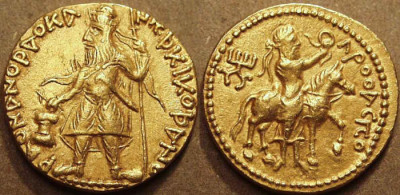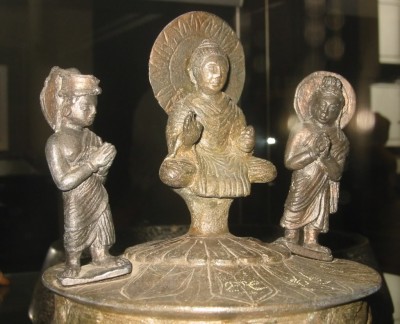King Kanishka- Kushan Empire
Emperor Kanishka History
Kanishka was the King of the Kushan Empire in Central Asia. He was the third king of the Kushan Dynasty. He was very famous for his military, political and spiritual achievements. His principal capital was Peshawar, Purushapura, present in northern Pakistan. The regional capitals are in the modern city of Taxila in Pakistan, Begram in Afghanistan and Mathura in India. Emperor Kanishka was a Kushan of Yuezhi ethnicity. He spoke an Indo-European language related to Tocharian and followed the Greek script in his inscriptions. The King was the successor of Vima Kadphises, and the administration was very impressive among the genealogy of the Kushan Kings.

There are so many legendary stories about him preserved in Buddhist religious scriptures. He was equally admired as Ashoka, Harshavardhana and into Greek Menander I. He followed the Buddhist tradition and also considered Buddhists to have been one of the greatest Buddhist Kings. Based on Harry Falk’s groundbreaking research, the brilliant administrative efforts that made others follow Kanishka’s era were generally accepted to have begun in 127 CE. Kushans used Kanishka’s era as a calendar reference by the Kushans kings for about a century until the decline of the Kushan realm.
The extent of the Kanishka Empire:
Emperor Kanishka conquered the neighbouring territories and expanded the kingdom in every corner of central Asia. The Kushan empire was vast and one of the largest kingdoms in ancient India. It extended from southern Uzbekistan and Tajikistan, north of the Amu Darya(Oxus) in the North West to Northern India, as far as Mathura in the southeast. Kushan empire also included Kashmir, where a town Kanishkapur named after him.
According to the Chinese records China, general Ban Chao fought battles with a Kushan army of 70,000 men led by a Kushan Viceroy Xie(Chinese) near Khotan in 90 CE. First, general Ban Chao claimed victory but finally used a scorched-earth policy; the region fell to Kushan forces in the early 2nd century. As a result, the territory of the Kushans extended to Kashgar, Khotan and Yarkand, which were in the Tarim Basin, modern Xinjiang. Several coins of Kanishka were founded in the Tarim Basin.

King Kanishka Coins
King Kanishka’s coins are very famous; the present historians got a lot of information about the Kanishka empire. They estimated the lifestyle and administration of the Kushan Dynasty. The coins portray images of Indo-Aryan, Greek, Iranian and even Sumero-Elamite divinities, demonstrating the religious syncretism in his beliefs. The Kanishka coin scriptures were written in The Greek language. Later coins contained the Bactrian language, and Iranic ones replaced the Greek gods on the coins. The King wears largely rounded boots on his coins, armed with a long sword. His clad was in a long coat and trousers with flames emanating from his shoulders, and his face was depicted with a long beard.
Kanishka History in Buddhist Scriptures
The King’s reputation was primarily discussed in Buddhist scriptures. He followed the Buddhist tradition, conducted the 4th Buddhist council in Kashmir, and encouraged the Gandara School of Greko-Buddhist Art and the Mathura school of Hindu art. King Kanishka personally maintained religious equality. He had embraced both Buddhism and the Persian cult of Mithra. He held a close relationship with the Buddhist scholar Ashvaghosha; later, he became a religious advisor.
The standing Buddha held the left corner of his cloak in his hand and formed the Abhaya Mudra. All these coins were minted in gold and small in size compared to the other gold coins of Kanishka. On the cash, the Buddha represented wearing the monastic robe. The ears are huge and long and have an abundant topknot covering Anisha. Later these styles were carved on the Buddha statues of Gandhara.

Kanishka Casket in Peshawar
The archaeological excavations were held during the year 1908-1909 in Shah-Ji-Dheri on the outskirts of Peshawar. The Archaeologists discovered a deposition chamber under Emperor Kanishka’s stupa. It is today at the Peshawar Museum. It contains three bone fragments of the Buddha, now in Mandalay, Burma—the casket is decorated with Buddha and his worshipping. The lid coffin shows the Buddha on a lotus pedestal and is worshipped by Brahman and Indra. The body of the casket represents the King with the Iranian Sun and Moon gods. On the sides of the casket, two images of a seated Buddha worshipped by royal figures.
King Kanishka’s Contribution to Buddhism
Initially, the King was a violent, faithless ruler and ruthless tyrant. Once he embossed Buddhism, he tried to spread peace like Ashoka. The conquest of the Tarim Basin caused the transmission of Buddhism to China. Probably in the 2nd century, the Buddhist monks played a vital role in developing and spreading Buddhist teachings and ideas in the direction of Northern Asia. Above all, the matters indicate, king Kanishka was not only a great emperor but also the patron of Buddhism.
Yeah my name is kanishka.
Needed more about contribution to Buddhism
But what are the contribution